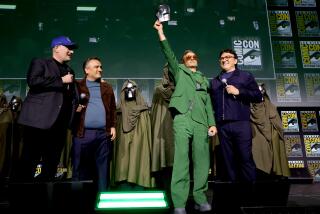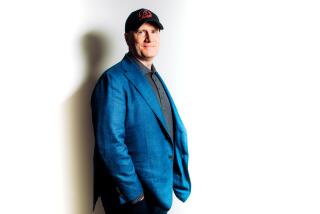Drawing On the Cool Factor : Comics: After defecting from Marvel, superstar Rob Liefeld hopes his ‘Youngblood’ series will strike a blow for cartoonists’ rights.
- Share via
Batman has Robin. Superman comes with Lois Lane and Jimmy Olson. But only “Youngblood” has ‘90s-style sidekicks: Spin doctors. Speech writers. Video trainers. Wardrobe consultants with expertise in spandex.
This is not just a comic book for the MTV Generation. It’s from the MTV Generation. And “Youngblood”--the new, in-your-face group of superheroes--is taking the comic book industry by storm.
It’s the work of 24-year-old Fullerton resident Rob Liefeld, the superstar cartoonist who set a comic book sales record after he began drawing Marvel Comics’ “X-Force” series in 1991.
Two months ago, after it was reported that Liefeld and five other top Marvel cartoonists had defected to upstart Malibu Graphics, Marvel’s stock plunged $11 a share. Meantime, advance sales soared for “Youngblood,” Liefeld’s first post-defection comic.
Though “Youngblood” can’t be purchased until Thursday, retailers’ orders have exceeded 600,000 copies. And it was the nation’s best-selling comic book for February, according to the trade magazine Internal Correspondence.
In fact, there’s been so much hype surrounding “Youngblood”--described by Liefeld as “media darlings” and “the superheroes’ superheroes”--that their debut is being treated like a Hollywood premiere by the Melrose Avenue branch of the Golden Apple comic book chain.
Klieg lights will line the sidewalk Thursday night. Liefeld is set to autograph the first 1,000 copies of “Youngblood.” And the crowd is expected to be enormous, considering that first issues of Superman now fetch as much as $47,000. Buyers of the $2.50 comic will receive a signed and numbered “First Day of Issuance Certificate.”
Negotiations are also in progress for posters, games and trading cards.
“And we’re looking into toy deals and T-shirt deals,” says Cheri Liefeld, the cartoonist’s older sister, who began handling his licensing and business arrangements about a month ago.
Liefeld was the first to defect. He and the others who followed say they did it because Marvel only paid them royalties on comic books sold and offered little creative control. While that arrangement provided them with comfortable incomes--Liefeld will only liken his to that of a doctor or lawyer--the cartoonists did not own rights to the characters they created for Marvel. Nor did they collect licensing profits, which can run into the millions.
Malibu Graphics, a 6-year-old, privately held firm, offered the Marvel stars the opportunity to own their characters and exercise complete creative control.
“Marvel has been very slow to give individual artists a lot of control or influence over their characters because all the characters belong to Marvel, not the artists,” says Melchoir Thompson, a Burlingame, Calif.-based consultant to comic book publishers, distributors and retailers. “Basically Malibu is acting as a printer and not as a real editor.”
Dave Olbrich, Malibu’s publisher agrees: “Our interest with all the creators we work with is for them to have as much creative control as possible over properties they own. It makes more sense.”
Until the Image Comics imprint was created, Malibu, actually based in Westlake Village, was best known as a publisher of TV nostalgia books and adaptations of classic novels. When the signing of Liefeld and the others was announced, Malibu was estimated to have 3% of the comic book market. Marvel has an estimated 50%.
To Liefeld, working for corporate giant Marvel amounted to being “asked to step into the creative process at point A and get off at point B. You take it to the next step, then take a hike.
“I have no gripe with Marvel,” he says, while inking a sketch at his drawing board in his Extreme Studios, a suite of offices he has leased in a Fullerton commercial building.
“It was a deal. I got to work for them and create characters that I would be known for in the long run. . . . When you stop being hot in comics, the doorbell doesn’t ring quite so often. But if you create a hot character, it could have a life of 100 years or more. Peanuts. The Flintstones. I wanted something that would outlast my 15 minutes of fame.
“Towards the end, Marvel was thinking more and more ‘We made you. You didn’t make us. We are responsible for your success.’ Their position is that the characters are the key, not the artists who draw them.”
Marvel Entertainment Group President Terry Stewart declined to be interviewed but issued this statement: “Rob is a tremendously gifted artist. And we’re very appreciative of the contribution he has made to Marvel. The primary force driving Marvel will always be our characters, who have been interpreted by literally thousands of writers and artists over seven decades.”
The fact is, many savvy comics fans are as enamored of comic book creators as comic book characters. Consider the scene that unfolded recently when Cheri Liefeld traveled with her brother to a comic book convention in New York City.
“There were people in line steadily for eight hours, waiting for him to autograph comic books,” she says. “He was in a room on the second floor of the hotel. The line went around the room, down the hall and then stopped at the escalator. Outside, it continued around the front of the hotel and all the way down the block. I’d say there were 5,000 people in the line throughout the day.”
Or as Liefeld’s friend and fellow Marvel defector Todd McFarlane says, “Rob’s cool factor is real high. The cool factor is what gets kids. They open the book and go, ‘Aahhh, cool, man.’ The visuals in Rob’s books will force you to stop and look if for no other reason than the cool factor.”
McFarlane, 27, also broke sales records with his “Spider-Man” books for Marvel. Next month, his “Spawn” comic debuts for Image Comics and advance orders have exceeded 800,000--more than those for “Youngblood.”
“Spawn” will eventually incorporate appearances from Liefeld’s “Youngblood” team, a government strike force of artificially and genetically advanced super beings.
“The ‘Youngblood’ characters are a lot like Rob himself,” McFarlane allows. “They’re young. They’re hip. They’re in the public eye. They’re trendsetters.”
As Liefeld continues inking a sketch, he makes it clear he’s thought a lot about trends, cool factors and media mastery--with regard to his “Youngblood” characters. But his own success appears to have come about far more naturally.
When he was growing up in Orange County, Liefeld was introduced to comics at about age 5 during trips to the barbershop. He became an instant fanatic and taught himself to draw comic characters shortly after he learned how to color.
Eventually, Liefeld turned as many homework assignments as possible into comics projects.
At Fullerton College, he took a few art classes, but gave them up when his dream of being a full-time cartoonist came true at age 19.
Liefeld’s first job was drawing D.C. Comics’ “Hawk and Dove.” A few months later, he began working for Marvel, where he stayed for 4 1/2 years. At 20, he won the Best New Artist award, voted by the customers at the L.A.’s three Golden Apple comic book stores.
“I think Rob’s developed almost an attitude about the way he portrays action and character development. You can tell it’s a Rob Liefeld drawing,” says Golden Apple owner Bill Liebowitz. “He’s struck a chord with fans.”
Advertisers, too. Liefeld says he agreed to appear in one of Spike Lee’s commercials for Levi’s 501 Jeans because he wanted to help upgrade the image of cartoonists.
As he explains, with his eyes still fixed on his drawing board, “You’re not thinking about fame and fortune when you’re into comics. I just wanted to draw guys who knock down buildings.”
More to Read
The biggest entertainment stories
Get our big stories about Hollywood, film, television, music, arts, culture and more right in your inbox as soon as they publish.
You may occasionally receive promotional content from the Los Angeles Times.










